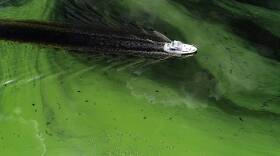-
Researchers hope the study can eventually find a way to predict when blooms will occur, and how to reduce their effects on beach life.
-
Professors and students at the University of South Florida mapped pitch, rhythm and duration to data about algae blooms and depletion of coral reefs to create an original composition.
-
Nutrients from stormwater and reclaimed water are feeding red tide algae blooms, according to findings from a peer-reviewed study out of the University of Florida.
-
Hurricane Ian not only ravaged southwest Florida on land but was destructive underwater as well. It destroyed man-made reefs and brought along red tide, the harmful algae blooms that kill fish and birds, according to marine researchers.
-
Sarasota researchers find evidence that airborne exposure to red tide could have neurological impactA new study by the Roskamp Institute, found participants exhibited symptoms previously only associated with eating contaminated seafood.
-
A record amount of seaweed is smothering Caribbean coasts from Puerto Rico to Barbados as tons of brown algae kill wildlife, choke the tourism industry and release toxic gases.
-
He said the state court system “already has a running start on the closure of Piney Point” and pointed to $100 million that the Legislature approved last year to help clean up the site.
-
Alternatives for how the U.S. Army Corps Of Engineers plans to manage the lake all propose increasing water levels during the dry season to above 17 feet, raising concerns about the health of the lake.
-
How high should Lake Okeechobee go? A new plan could redefine the lake. Manatees are dying off at faster rates than in years past. Plus, Key West, key lime pie bakers and a mysterious murder in Sundial's Book Club pick for this month.
-
As algae blooms across Florida worsen, the state has tightened rules for using biosolids created from treated sewage that contain nutrients fueling the blooms. Environmentalists say the rules continue to ignore a loophole for more treated sewage that makes up about 40% of the state's waste.
-
A lethal Gulf Coast red tide that littered beaches with dead wildlife in 2018 is back and this time around, it's claiming one of North America's rarest…
Play Live Radio
Next Up:
0:00
0:00
Available On Air Stations











